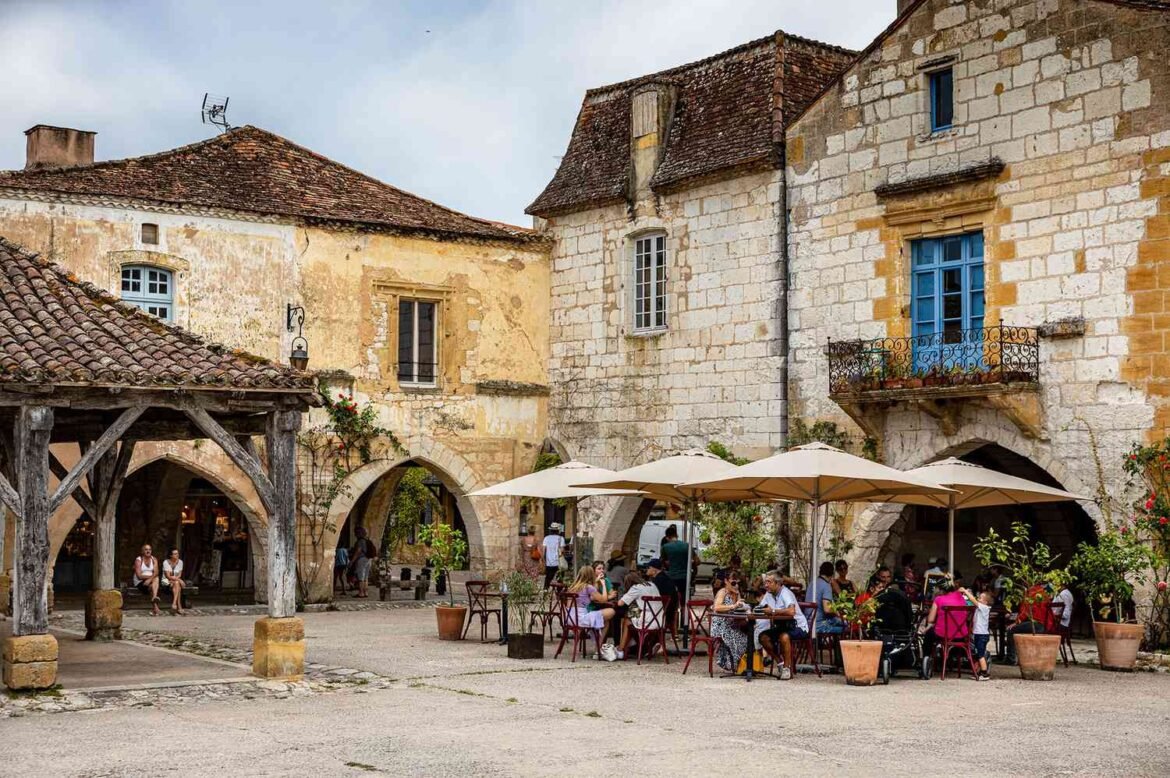:max_bytes(150000):strip_icc():format(jpeg)/TAL-header-monpazier-places-des-cornieres-DORDOGNE0525-ec05654faff743408fbf0310c3a62edb.jpg)
Ridley Scott has a thing for Monpazier. After first filming “The Duelists,” starring Harvey Keitel, in the southwestern French town in 1977, the British director returned for 2021’s medieval tale, “The Last Duel,” with Matt Damon, Ben Affleck, and Adam Driver.
As I stand in the middle of Place des Cornières, the main square, I can understand why. This town in France’s Dordogne region is a ready-made film set, particularly for glossy historical dramas. Cornières (angular arches) frame the square and glow in gold when the mid-morning light touches its buttercream stone buildings. Streets fan out in perfect geometry: Some, small alleys known as carreyous, are only two meters wide. Once hidden passages that allowed residents to scuttle around the village without paying taxes, the centuries-old stonework now conceals stylish, contemporary lodgings from public view.
Déclic & Décolle/Dordogne Departmental Tourism Committee
A British king, Edward I, founded this French town in 1284, in the shadow of the imposing Château de Biron, the largest of the Dordogne’s thousand or so castles. Bloodlines had granted British monarchs the right to territory in Aquitaine, the southwestern nook of France, much to the rancor of their French rivals. Bastides, or towns built around a central square, were strategically rigged around this pocket of France like defensive pawns on a chessboard. Of them, Monpazier is considered the most beautiful.
Déclic & Décolle/Dordogne Departmental Tourism Committee
All claims the British held over French land had evaporated by the mid-15th century, yet, like Scott, they continue to be drawn to Monpazier—and the Dordogne in general. So popular is this part of the world with visitors and second-home owners from across the channel that it has earned the nickname Dordogne-shire. Curiously, the region remains under the radar for many North American travelers—perhaps because there are no direct flights from the U.S. to the closest main airports, Bordeaux (BOD) and Toulouse (TLS), nor the main regional gateway, Bergerac (EGC).
Luc Fauret/Dordogne Departmental Tourism Committee
But this “other” south of France should be in your travel plans. The Dordogne is a glorious landscape of winding rivers, centuries-old chateaux, prehistoric caves, and tricolor vineyards. Local specialities reared on these soils—a treasure trove of black Périgord truffles, pâtés, foie gras, walnuts, cheeses, cep mushrooms, and strawberries.
Leaving Monpazier, I drive 30 minutes west across rural pastures toward the village of Issigeac, where up to 15,000 people cram into the streets every Sunday morning to fill their baskets with fresh fruit and vegetables at the famous produce market. Overlooking the scene is La Brucelière d’Issigeac, a 17th-century inn at the entrance to the historic center. The current custodians—French couple Marie and Anthony Hardy—moved south from Brittany last year, where Anthony, who has worked for Gordon Ramsay, was heading up the Michelin-starred Château de Sable.
Dordogne Libre/Dordogne Departmental Tourism Committee
My main course of filleted skate, roasted cauliflower, parsnip puree, and hazelnuts is plated to perfection on bespoke pottery handmade by Marité Labat, the village ceramist. After watching the sun set over the restaurant’s garden terrace, I only have to walk upstairs, where five rooms brimming with rustic charm serve as guest accommodations.
‘Périgord is the Dordogne’s historic name, and the region is still commonly referred to by it, more often than not accompanied by one of four colors: vert (green), blanc (white), noir (black), and pourpre (purple). Monpazier, Issigeac, and other villages like Eymet (which has a large concentration of Brits) are in the purple Périgord, named for the vineyards that crisscross the territory around Bergerac on the Dordogne river.
Château Feely/Dordogne Departmental Tourism Committee
Vineyards stretch as far as I can see from my vantage point at Château Feely in the sleepy village of Saussignac the next morning. As owner, Sean Feely, tends to the vines, his wife and co-owner, Caro, and I walk among rows of gnarly, old-vine merlot, careful to avoid the new buds of wild violet orchids poking through the soil between them. She tells me how they traded city life in Dublin for the French idyll two decades ago, buying a rundown estate with a water source that dates back to Gallo-Roman times. A commitment to quality and organic and biodynamic principles has kept their dream going, as has diversification into wine classes, yoga in the vines, walking tours through the surrounding countryside, and self-catered, eco-friendly accommodations.
Dan Courtice/Dordogne Departmental Tourism Committee
Heading north, the dry, vine-filled plains fade out and I cut through the white Périgord, a nod to the chalky soils and stone typical of the landscape at the center of the Dordogne. I don’t need a map to tell me when I’ve arrived in the green Périgord, where the emphasis is on slowing down in nature on bike paths, hiking trails, and canoe rides down the gentle Drôme river, past old mills converted into charming riverbank boltholes, none more so than Les Griffons. Atmospheric rooms at this hotel in the tiny yet enchanting village of Bourdeilles feature antique stone fireplaces, wooden beams, and calming water views.
Déclic & Décolle/Dordogne Departmental Tourism Committee
I round out my Dordogne adventure in the black Périgord, a reference to the dense, almost inky oak forests that I spend more than an hour driving through en route to Saint-Léon-sur-Vézère, little more than a cluster of historic, golden stone homes bearing the Dordogne’s traditional steep-pitched roofs made from lauze (limestone) tiles.
Gregory Cassiau/Les Conteurs/Dordogne Departmental Tourism Committee
Across the street from Manoir de la Salle, a 14th-century manor with sweeping gardens in immaculate condition, I sit down for lunch at Le Petit Léon, the restaurant of Antipodean chef Nick Honeyman and his sommelier wife, Sina. Honeyman, who runs the acclaimed Paris Butter in Auckland, New Zealand, explains how they took over this seasonal bistro in 2020 as an excuse for a paid European vacation every summer. His menu, which combines local ingredients with influences from Asia-Pacific plus New Zealand wines, quickly caught the attention of the French food scene, including the Michelin inspectors, who awarded Honeyman his first star in 2024.
Esoler Photographie/Le Petit Leon/RoBo
The restaurant is now open from April until October, and the couple has recently unveiled another eatery, Ro.bo, in the nearby village of Montignac-Lascaux—famed for its network of prehistoric cave paintings. (In fact, Ro.bo is a nod to the dog, Robot, who led to the discovery of the cave network in 1940.)
The Honeymans are so inspired by what’s on their doorstep that they’ve made the region their permanent home. “The walls of this restaurant are 300 years old, the church in the village is from the 11th century,” Honeyman says. “The light here—I can’t explain it, but everywhere you look, it’s like someone has detailed everything with a fine liner. It’s spectacular.”
I’ve only been in the Dordogne for a few days, yet I can’t help but agree.


